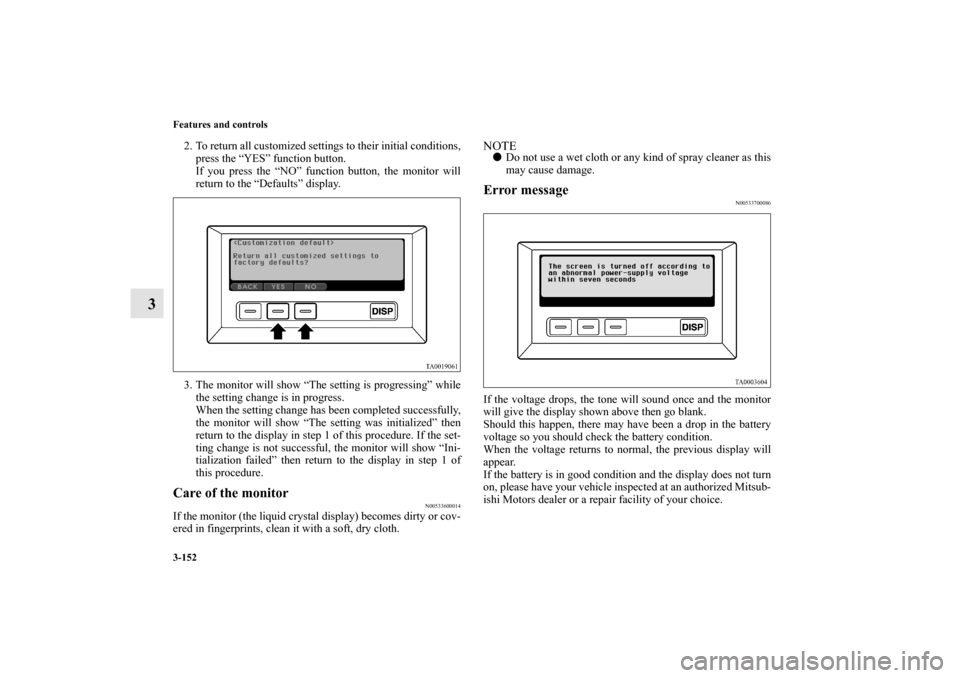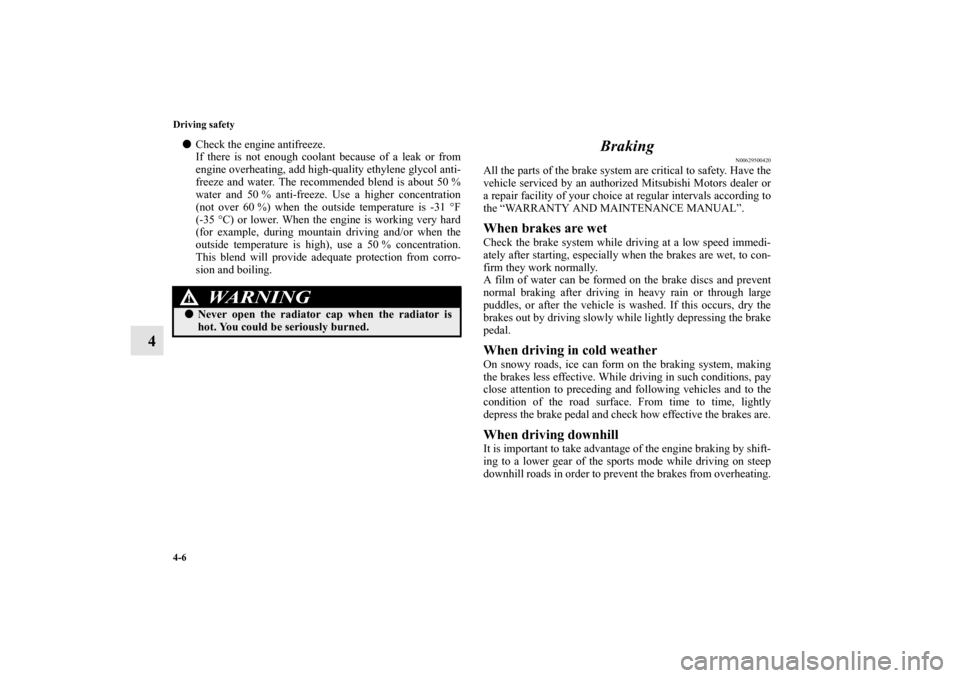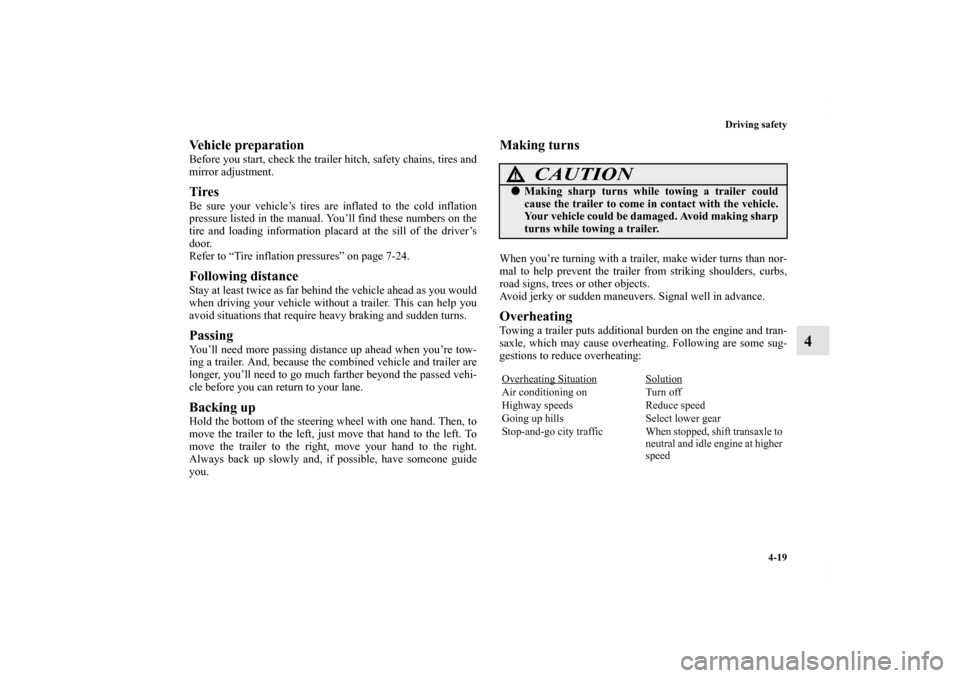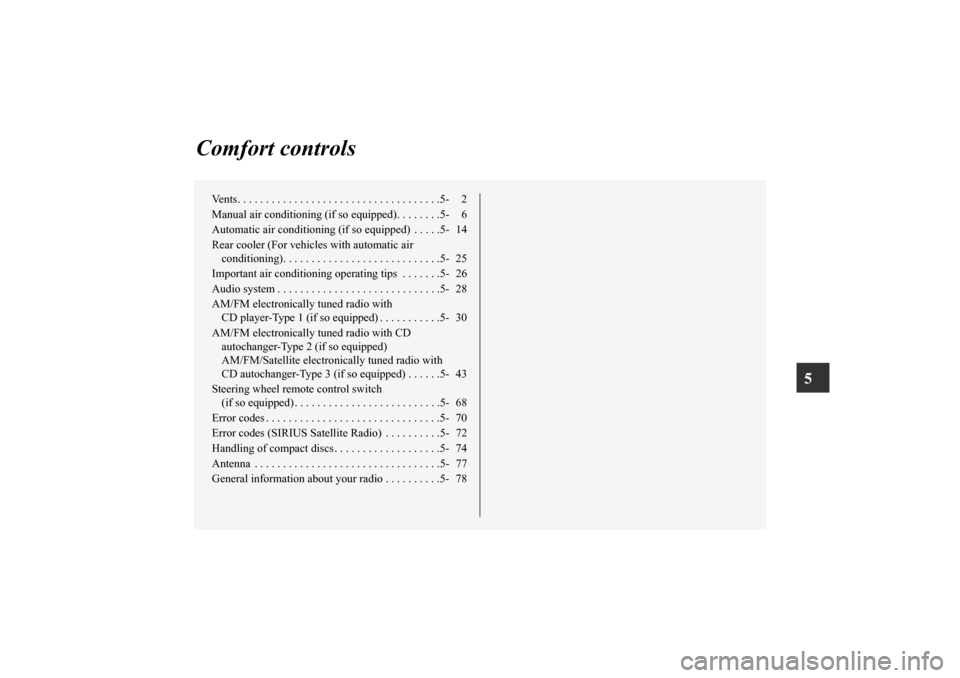Page 241 of 514

3-152 Features and controls
3
2. To return all customized settings to their initial conditions,
press the “YES” function button.
If you press the “NO” function button, the monitor will
return to the “Defaults” display.
3. The monitor will show “The setting is progressing” while
the setting change is in progress.
When the setting change has been completed successfully,
the monitor will show “The setting was initialized” then
return to the display in step 1 of this procedure. If the set-
ting change is not successful, the monitor will show “Ini-
tialization failed” then return to the display in step 1 of
this procedure.Care of the monitor
N00533600014
If the monitor (the liquid crystal display) becomes dirty or cov-
ered in fingerprints, clean it with a soft, dry cloth.
NOTE�Do not use a wet cloth or any kind of spray cleaner as this
may cause damage.Error message
N00533700086
If the voltage drops, the tone will sound once and the monitor
will give the display shown above then go blank.
Should this happen, there may have been a drop in the battery
voltage so you should check the battery condition.
When the voltage returns to normal, the previous display will
appear.
If the battery is in good condition and the display does not turn
on, please have your vehicle inspected at an authorized Mitsub-
ishi Motors dealer or a repair facility of your choice.
BK0102600US.book 152 ページ 2009年3月30日 月曜日 午後2時2分
Page 242 of 514
Features and controls
3-153
3
NOTE�The monitor may go blank without giving the error mes-
sage display shown above.
If the temperature inside the monitor increases excessively, a
tone will sound once and the monitor will give the display
shown above then go blank.
Park the vehicle in a shady place and open the windows to let
plenty of fresh air inside the vehicle.
When the temperature inside the monitor returns to normal, the
previous display will appear.
If the display does not turn on, please have your vehicle
inspected at an authorized Mitsubishi Motors dealer or a repair
facility of your choice.
Combination headlights and dimmer switch
N00522500488
Headlights Rotate the switch to operate the lights.
As your vehicle is equipped with daytime running lights, the
combinations of switch operations and illuminated lights differ
in accordance with the following conditions.
BK0102600US.book 153 ページ 2009年3月30日 月曜日 午後2時2分
Page 301 of 514

4-2 Driving safety
4Driving precaution
N00629300040
Utility vehicles have higher ground clearance and a narrower
track, which enables them to perform in a wide variety of off-
road situations. Because of the higher ground clearance, these
vehicles have a higher center of gravity, which makes them
handle differently than ordinary vehicles when driving on
pavement. They are not designed to maneuver or corner at the
same speed on pavement as conventional 2-wheel drive pas-
senger cars any more than low-slung sports cars are designed
to perform satisfactorily in off-road conditions.
Always drive safely and steer the vehicle carefully. Avoid oper-
ating the vehicle in a manner that might require sharp turns or
abrupt maneuvers. As with other vehicles of this type, failure
to operate this vehicle correctly can result in loss of control or
vehicle rollover.
In a rollover crash, an unbelted person is significantly more
likely to die than a person wearing a seat belt. Before starting
the vehicle, always make certain that you and all your passen-
gers are properly wearing their seat belts (with children in the
rear seat, in appropriate restraints).
Fuel economy
N00628800080
Fuel economy is dependent on many factors. Your personal
driving habits can have a significant effect on your fuel use.
Several recommendations for achieving the greatest fuel econ-
omy are listed below.
�Whenever accelerating from a stop, always accelerate
slowly and smoothly.
�When parked for even a short period, do not idle the
engine. Shut it off.
�Plan your trips to avoid unnecessary stops.
�Keep your tires inflated to the recommended pressures.
�For freeway driving, maintain a speed of approximately
50 mph (80 km/h) when traffic, roadway and weather con-
ditions safely permit.
�Keep your air filter clean and your vehicle lubricated
according to the recommendations in this manual.
�Always keep your vehicle well maintained. A poorly
maintained engine wastes fuel and costs money.
�Do not overload your vehicle.
WA R N I N G
!�Utility vehicles have a significantly higher rollover
rate than other types of vehicles. Avoid abrupt
maneuvers and excessive speed. Always buckle up.
BK0102600US.book 2 ページ 2009年3月30日 月曜日 午後2時2分
Page 305 of 514

4-6 Driving safety
4
�Check the engine antifreeze.
If there is not enough coolant because of a leak or from
engine overheating, add high-quality ethylene glycol anti-
freeze and water. The recommended blend is about 50 %
water and 50 % anti-freeze. Use a higher concentration
(not over 60 %) when the outside temperature is -31 °F
(-35 °C) or lower. When the engine is working very hard
(for example, during mountain driving and/or when the
outside temperature is high), use a 50 % concentration.
This blend will provide adequate protection from corro-
sion and boiling.
Braking
N00629500420
All the parts of the brake system are critical to safety. Have the
vehicle serviced by an authorized Mitsubishi Motors dealer or
a repair facility of your choice at regular intervals according to
the “WARRANTY AND MAINTENANCE MANUAL”.When brakes are wetCheck the brake system while driving at a low speed immedi-
ately after starting, especially when the brakes are wet, to con-
firm they work normally.
A film of water can be formed on the brake discs and prevent
normal braking after driving in heavy rain or through large
puddles, or after the vehicle is washed. If this occurs, dry the
brakes out by driving slowly while lightly depressing the brake
pedal.When driving in cold weatherOn snowy roads, ice can form on the braking system, making
the brakes less effective. While driving in such conditions, pay
close attention to preceding and following vehicles and to the
condition of the road surface. From time to time, lightly
depress the brake pedal and check how effective the brakes are.When driving downhillIt is important to take advantage of the engine braking by shift-
ing to a lower gear of the sports mode while driving on steep
downhill roads in order to prevent the brakes from overheating.
WA R N I N G
!�Never open the radiator cap when the radiator is
hot. You could be seriously burned.
BK0102600US.book 6 ページ 2009年3月30日 月曜日 午後2時2分
Page 318 of 514

Driving safety
4-19
4
Vehicle preparationBefore you start, check the trailer hitch, safety chains, tires and
mirror adjustment.TiresBe sure your vehicle’s tires are inflated to the cold inflation
pressure listed in the manual. You’ll find these numbers on the
tire and loading information placard at the sill of the driver’s
door.
Refer to “Tire inflation pressures” on page 7-24.Following distanceStay at least twice as far behind the vehicle ahead as you would
when driving your vehicle without a trailer. This can help you
avoid situations that require heavy braking and sudden turns.PassingYou’ll need more passing distance up ahead when you’re tow-
ing a trailer. And, because the combined vehicle and trailer are
longer, you’ll need to go much farther beyond the passed vehi-
cle before you can return to your lane.Backing upHold the bottom of the steering wheel with one hand. Then, to
move the trailer to the left, just move that hand to the left. To
move the trailer to the right, move your hand to the right.
Always back up slowly and, if possible, have someone guide
you.
Making turnsWhen you’re turning with a trailer, make wider turns than nor-
mal to help prevent the trailer from striking shoulders, curbs,
road signs, trees or other objects.
Avoid jerky or sudden maneuvers. Signal well in advance.OverheatingTowing a trailer puts additional burden on the engine and tran-
saxle, which may cause overheating. Following are some sug-
gestions to reduce overheating:
CAUTION
!�Making sharp turns while towing a trailer could
cause the trailer to come in contact with the vehicle.
Your vehicle could be damaged. Avoid making sharp
turns while towing a trailer. Overheating Situation
Solution
Air conditioning on Turn off
Highway speeds Reduce speed
Going up hills Select lower gear
Stop-and-go city traffic When stopped, shift transaxle to
neutral and idle engine at higher
speed
BK0102600US.book 19 ページ 2009年3月30日 月曜日 午後2時2分
Page 320 of 514

5
Comfort controls
Vents. . . . . . . . . . . . . . . . . . . . . . . . . . . . . . . . . . . .5- 2
Manual air conditioning (if so equipped). . . . . . . .5- 6
Automatic air conditioning (if so equipped) . . . . .5- 14
Rear cooler (For vehicles with automatic air
conditioning). . . . . . . . . . . . . . . . . . . . . . . . . . . .5- 25
Important air conditioning operating tips . . . . . . .5- 26
Audio system . . . . . . . . . . . . . . . . . . . . . . . . . . . . .5- 28
AM/FM electronically tuned radio with
CD player-Type 1 (if so equipped) . . . . . . . . . . .5- 30
AM/FM electronically tuned radio with CD
autochanger-Type 2 (if so equipped)
AM/FM/Satellite electronically tuned radio with
CD autochanger-Type 3 (if so equipped) . . . . . .5- 43
Steering wheel remote control switch
(if so equipped) . . . . . . . . . . . . . . . . . . . . . . . . . .5- 68
Error codes . . . . . . . . . . . . . . . . . . . . . . . . . . . . . . .5- 70
Error codes (SIRIUS Satellite Radio) . . . . . . . . . .5- 72
Handling of compact discs . . . . . . . . . . . . . . . . . . .5- 74
Antenna . . . . . . . . . . . . . . . . . . . . . . . . . . . . . . . . .5- 77
General information about your radio . . . . . . . . . .5- 78
BK0102600US.book 1 ページ 2009年3月30日 月曜日 午後2時2分
Page 321 of 514
5-2 Comfort controls
5Ve n t s
N00729900092
NOTE�Do not place beverages on top of the instrument panel. If
they splash into the air conditioning vents, they could
damage the system.
Air flow and direction adjustments
N00730200271
Center ventsAdjust the horizontal direction of the air flow by turning the
dial (A).
The vent can be opened and closed with the dial (A).
Adjust the vertical direction of the air flow by turning the dial
(B).
1- Center vents
2- Side vents
3- Rear vents (for vehicles with automatic air conditioning)
Left side Right side
Open
CloseOpen
Close
BK0102600US.book 2 ページ 2009年3月30日 月曜日 午後2時2分
Page 322 of 514
Comfort controls
5-3
5
Side/Rear (for vehicles with automatic air conditioning)
ventsAdjust the direction of the air flow by moving the knob (C).NOTE�On rare occasions, air from the vents of an air-conditioned
vehicle may be foggy. This is only moist air cooling sud-
denly and does not indicate a problem.
Changing the mode selection
N00736400435
To change the position and amount of air flowing from the
vents, turn the mode selection dial. (Refer to “Mode selection
dial” on page 5-7, 5-18.)
These symbols are used in the next several illustrations to dem-
onstrate the quantity of air coming from the vents.
: Small amount of air from the vents
: Medium amount of air from the vents
: Large amount of air from the vents Face position Air flows only to the upper part of the passenger compartment.
Side vents Rear vents
BK0102600US.book 3 ページ 2009年3月30日 月曜日 午後2時2分